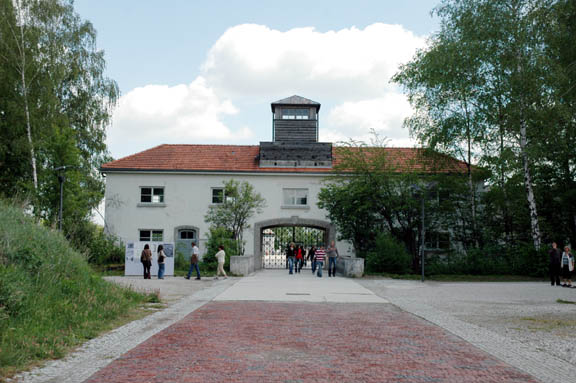
Survivors of Auschwitz-Birkenau with Russian soldier who helped to liberate the camp
A photo that is very similar to the one above is shown in a news article about the Sonderkommando Jews who were forced to help the Nazis, in the killing of the Jews at Auschwitz-Birkenau.
The following quote is from the news article which you can read in full at http://www.haaretz.com/world-news/europe/.premium-1.773405
Begin quote from news article:
The members of the Sonderkommando in Auschwitz worked in the gas chambers. They were posted to the undressing rooms, where the victims had to disrobe; they were responsible for the removal of the bodies after the murder; for removing valuables from the bodies; for burning the bodies; for dealing with the body parts that did not burn completely; and finally they carried the ashes to the river and dumped them in the water.
As Shaul Chazan, one of the Sonderkommando survivors, told me: At 9:30, a transport of 3,500 people would arrive, and four hours later, not a trace of them remained – as though they had never existed. [Chazan’s testimony appears in Greif’s “We Wept Without Tears”; Yale University Press, 2005.] The Sonderkommando carried out all those tasks, but it’s important for me to emphasize that they never took part in the work of murder itself. They did not murder anyone. Only the Germans threw the deadly gas into the chambers.
End quote from news article
I wrote about the Sonderkommando Jews on my scrapbookpages.com website BEFORE I became a Holocaust denier.
Begin quote from my scrapbookpages.com website:
One of the survivors of Auschwitz was Samuel Pisar, who was first sent, at the age of 13, to the Majdanek death camp, in August 1943, when the Bialystok ghetto in Poland was liquidated. A few months later, he was transferred to Auschwitz-Birkenau where he was put to work.
In an article in the Washington Post, published on January 23, 2005, Samuel Pisar wrote the following about his experience at Birkenau:
My labor commando was assigned to remove garbage from a ramp near the Crematoria. From there I observed the peak of human extermination and heard the blood-curdling cries of innocents as they were herded into the gas chambers. Once the doors were locked, they had only three minutes to live, yet they found enough strength to dig their fingernails into the walls and scratch in the words “Never Forget.”
One of the Auschwitz-Birkenau prisoners, who loaded the corpses of the murdered Jews into the Crematoria ovens after they were killed in the gas chambers with Zyklon-B, was Schlomo Venezia who described his work in an interview with Adam L. Freeman, a reporter with the Bloomberg News, on December 17, 2007.
According to Freeman’s article, posted on the web site http://www.bloomberg.com, Schlomo worked for eight months at Birkenau in 1944, “…12 hours a day, seven days a week, cadaver after cadaver until it became a mechanical task, like feeding a heating furnace with cords of wood.”
Schlomo Venezia wrote a memoir entitled “Sonderkommando Auschwitz,” which was originally published in French; a new Italian version was published in 2007.
The following quote about Schlomo’s story is from Adam L. Freeman’s article in the Bloomberg News on December 17, 2007:
Begin quote from news article:
He [Schlomo] recalls, for example, the day he met his father’s emaciated cousin in an undressing room at the gas chambers. Venezia offered him the only solace possible, he writes — some sardines and a lie that the Zyklon B would kill him quickly.
“It was just terrible to have to lie, but there was no way around it,” Venezia explains. “I tried in some way to make the horrible situation easier.”
The Sonderkommandos, as the prisoners working at the gas chambers were known, were privy to how the Nazis went about their butchery. Determined to keep their methods secret, the Nazis killed members of these units at regular intervals, making Venezia’s memoir rare.
He was 20 years old at the time; he will turn 84 on Dec. 29. His own mother was murdered at the camp while he worked at the ovens — one of more than 1 million Jews killed there.
As we talk over a table of ties in his one-room shop near the Trevi Fountain, Venezia remains almost motionless. His Hungarian-born wife, Marika, tends to shoppers entering through the glass door. At one point, she places a box of coffee-filled chocolates between us.
The descendant of an old Jewish family from Spain and Italy, Venezia was born in the northern Greek city of Thessaloniki, where he grew up fatherless and poor, speaking Greek, Italian and Ladino, a Spanish-Jewish dialect.
Poverty sharpened his wits, he says. Working the black market in Nazi-occupied Greece, Venezia learned some German, which may have saved his life. In the camp, he escaped beatings by understanding when guards shouted out the number tattooed on his arm: 182727.
Cutting the hair off cadavers, pulling their gold teeth and dragging them to the furnaces became mechanical, Venezia says, because it was the only way to stay sane. The routine broke down only once, he recalls, when the prisoners were confronted with the lifeless body of a woman possessing “the absolute beauty of an ancient statue.”
She looked like “a woman in a painting,” Venezia says, pausing for a moment in reflection. “Like Mona Lisa.” Yet there was nothing to do but cremate her.
Another day, his unit found a live baby trying to suck its dead mother’s breast among a heap of corpses in a gas chamber. The prisoners watched without protest as a Nazi guard unloaded his pistol into the infant.
“There were so many terrible things that happened,” he says. “Every day it was something else.”
End quote












